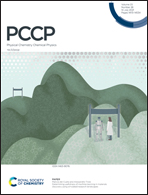Observation and deconvolution of a unique EPR signal from two cocrystallized spin triangles†
Abstract
A 16-line pattern has been theoretically predicted, but hitherto not reported, for the Electron Paramagnetic Resonance (EPR) spectrum of antiferromagnetically coupled CuII triangles experiencing isotropic exchange of isosceles magnetic symmetry. Now, the crystallization of such a triangular species and its X-ray structure determination in a polar space group, R3 (No. 146), has enabled its single crystal EPR study. Its detailed magnetic susceptibility, and X- and Q-band, powder and single crystal EPR spectroscopic study reveals the effect of molecular structure and of Dzyaloshinskii–Moriya interactions (DMI) on the g‖, g⊥ and A‖ parameters of the spectrum; DMI is considered for the first time in such a context. Moreover, careful analysis of the spectrum allows the deconvolution of two slightly different cocrystallized magnetic species.



 Please wait while we load your content...
Please wait while we load your content...